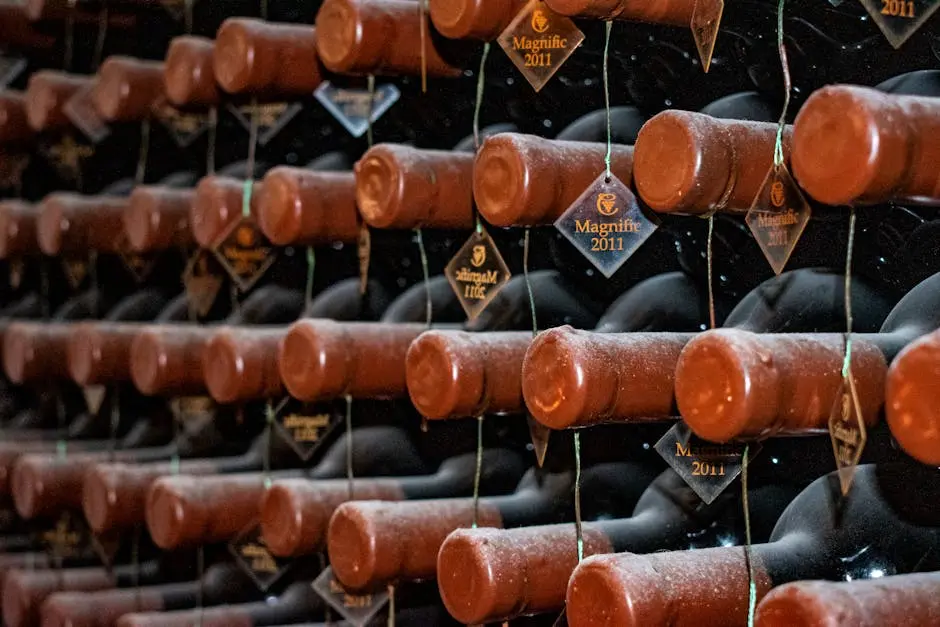Storing red wine correctly is crucial for preserving its quality and enhancing its flavors. Whether you’re a seasoned wine enthusiast or just starting your collection, understanding the ideal storage temperature for red wines is key. Let’s explore the steps to ensure your reds are stored to perfection.
Understanding the Importance of Temperature
Temperature plays a significant role in the chemical reactions that occur in wine, impacting its aging process and flavor profile. These reactions are crucial for the development of taste, aroma, and texture in red wines, making temperature one of the most important factors to control.
It’s fascinating how even minor fluctuations can alter a wine’s character significantly. For instance, wines stored at too high a temperature may age prematurely. This means you’ll taste a weaker, less vibrant wine than initially intended. In contrast, too cold temperatures can slow down the aging process, leading to a muted taste experience.
To understand why temperature is so critical, let’s delve deeper into the science of wine chemistry. As wine contains a delicate balance of alcohol, acidity, sugar, and tannins, the right temperature helps maintain this balance over time. Thus, carefully managing storage temperature ensures that red wines can be enjoyed exactly as the winemaker intended.
Ideal Temperature Range for Red Wines
The ideal storage temperature for most red wines is between 55°F and 65°F (13°C to 18°C). Keeping them within this range ensures balanced aging. This temperature is often referred to as ‘cellar temperature’, as it’s reminiscent of traditional wine caves.
Within this optimal range, the various components of wine harmonize perfectly. Tannins, in particular, benefit from this environment, as it allows them to mature, creating a richer, more nuanced wine. This carefully controlled maturing period can greatly enhance your overall red wine tasting experience.
Different styles of red wine have specific needs within this range. For instance, lighter reds like Pinot Noir might better preserve their subtle notes at the lower end, while fuller-bodied wines such as Cabernet Sauvignon often thrive closer to the higher end of the spectrum.
Consequences of Incorrect Storage Temperature
Storing wine above or below the ideal temperature can lead to spoilage, loss of flavor, and imbalance in the wine structure. Wines stored at high temperatures are prone to developing off-flavors, as the heat accelerates the breakdown of essential components.
Conversely, temperatures that are too cold can dull the sensory attributes of the wine. The wine might become flat or seem less aromatic if it’s kept at a freezing temperature for prolonged periods. Such conditions can impede the intended tasting experience and the wine’s overall enjoyment.
One should also be cognizant of the cumulative effects temperature stress can have over time. Even if the wine doesn’t spoil outright, repeated exposure to suboptimal conditions can diminish its quality. A wine’s potential to age well is highly dependent on consistent, appropriate storage.
Tips for Maintaining Consistent Temperature
Invest in a wine cooler or designate a special area in your home that can maintain a stable temperature and protect your wines from fluctuations. A well-insulated cellar or wine fridge can make all the difference in locking in the ideal storage conditions.
Look for devices with dual-zone technology if you have a diverse collection. This setup can cater to varying temperature needs, allowing both red and white wines to be stored optimally. This ensures that both types of wines are kept at their respective perfect conditions, enhancing longevity and flavor.
Aside from technology solutions, simple practices can help too. Ensure your storage area is away from direct sunlight, and shielded from vibrations and frequent environmental changes. Such physical conditions, alongside temperature, are crucial to successful wine storage.
Additional Considerations for Red Wine Storage
Alongside temperature, factors such as humidity, light exposure, and bottle positioning are also crucial in preserving the quality of your red wines. Adequate humidity, for instance, keeps corks from drying out and allows for a proper seal to be maintained.
Exposure to light, particularly sunlight, can cause a chemical reaction that speeds up the aging process and leads to premature deterioration. Thus, a dimly lit or completely dark storage environment is ideal for maintaining the quality of your wine collection.
The way bottles are positioned—preferably on their side—ensures the cork remains moist and prevents unwanted air from entering. Horizontal positioning is a simple yet effective way to keep your wines fresh and ready for that perfect moment when you choose to enjoy them.
Preserve Your Reds with Proper Storage
Storing red wine at the right temperature is essential for maintaining its quality and flavor. By following these guidelines, you can ensure that your red wines are always at their best, ready to offer a delightful tasting experience when you decide to uncork them. To learn more about how to take care of your wine collection or find out about our comprehensive wine storage solutions, visit our homepage.



